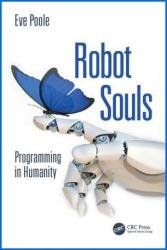Robot Souls: Programming in Humanity
- Добавил: literator
- Дата: 13-06-2023, 06:21
- Комментариев: 0
 Название: Robot Souls: Programming in Humanity
Название: Robot Souls: Programming in HumanityАвтор: Eve Poole
Издательство: CRC Press
Год: 2024
Страниц: 185
Язык: английский
Формат: pdf (true)
Размер: 10.2 MB
Two of the biggest design problems in Artificial Intelligence are how to build robots that behave in line with human values and how to stop them ever going rogue. One under-explored solution to these alignment and control problems might be to examine how these are already addressed in the design of humans.
Looking closely at the human blueprint, it contains a suite of capacities that are so clumsy they have generally been kept away from AI. It was assumed that robots with features like emotions and intuition, that made mistakes and looked for meaning and purpose, would not work as well as robots without this kind of code. But on considering why all these irrational properties are there, it seems that they emerge from the source code of soul. Because it is actually this ‘junk’ code that makes us human and promotes the kind of reciprocal altruism that keeps humanity alive and thriving.
Robot Souls looks at developments in AI and reviews the emergence of ideas of consciousness and the soul. It places our ‘junk code’ in this context and argues that it is time to foreground that code, and to use it to look again at how we are programming AI.
Machine Learning is the general term for the development of algorithms in AI that drive its autonomous development, using training data to enable the AI to make future predictions or decisions without being explicitly programmed to do so. Deep Learning has now taken this to a level of complexity that has produced a step-change in the progress of AI. Deep Learning is a term that has been popularised by Geoffrey Hinton and others since 2006, although more basic multi-linear Machine Learning networks have formally existed since the 1960s. Deep Learning was inspired by the discovery in the 1960s of the interplay between the simple and the complex cells in the visual cortex. These fire differentially in response to visual sensory inputs, and work as a team to identify the object in view. This insight informed the design of the artificial neural network architectures used in modern Deep Learning, which establish layers of problem- solving between artificial ‘ neurons,’ and a division of labour by layer, with multiple relationships and iterations between them, to optimise data processing. This architecture allows AI to move on from step-by-step problem-solving by simulating the fast and intuitive judgements that humans use to recognise patterns and anomalies.
Скачать Robot Souls: Programming in Humanity
[related-news] [/related-news]
Внимание
Уважаемый посетитель, Вы зашли на сайт как незарегистрированный пользователь.
Мы рекомендуем Вам зарегистрироваться либо войти на сайт под своим именем.
Уважаемый посетитель, Вы зашли на сайт как незарегистрированный пользователь.
Мы рекомендуем Вам зарегистрироваться либо войти на сайт под своим именем.
